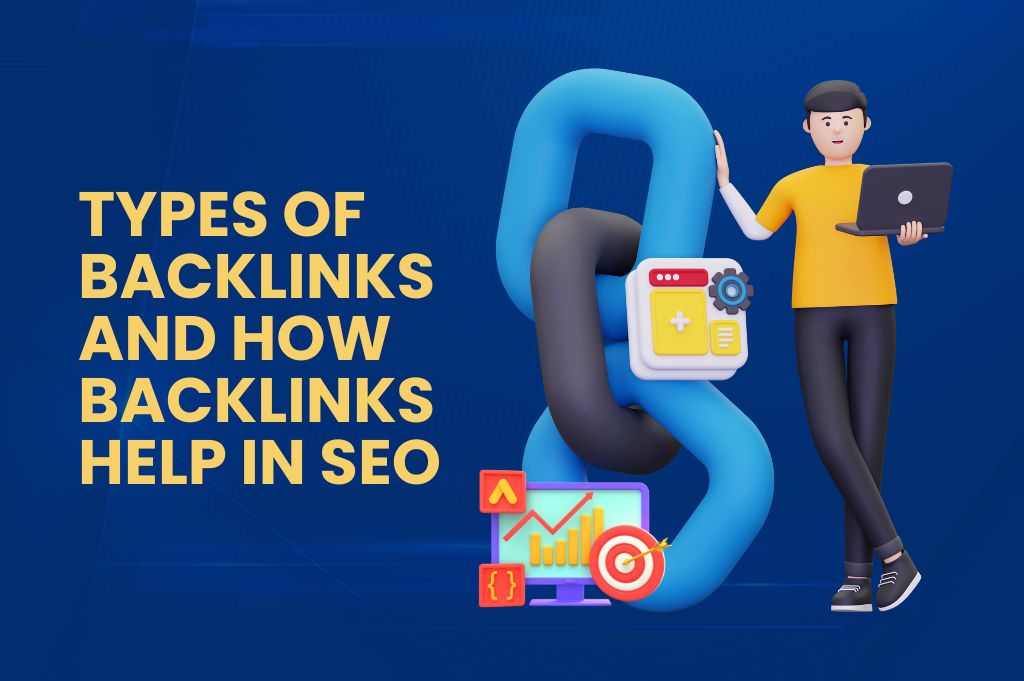Search Engine Optimization (SEO) plays a pivotal role in enhancing online presence, and backlinks are a fundamental component of SEO. Backlinks are links from one web to a page on another website. They signal search engines that the content on the linked page is worthwhile and trustworthy.
This blog post will explore types of backlinks, their significance in SEO, and effective strategies for building a strong backlink profile.
What are Backlinks?
Backlinks are the links from one site to another. They are fundamental for search engines like Google to determine a site’s credibility and relevance. Search engines use backlinks as a basic factor in their ranking algorithms.
A site with many high-quality backlinks will rank higher in SERPs than a site with fewer or lower-quality links. Backlinks have been a vital part of search engine algorithms since Google’s inception when its founders introduced the PageRank algorithm.
Must Read: What is included in SEO?
How do Backlinks Help in SEO?
1. Improves Search Engine Rankings
Google’s PageRank algorithm evaluates the number and quality of backlinks to determine a webpage’s importance and rank. High-quality backlinks from authoritative websites indicate to Google that your content is valuable and trustworthy. Having a few high-quality backlinks from reputable sites is more beneficial than numerous low-quality ones. Search engine always prioritizes the relevance and authority of the linking site.
To acquire high-quality backlinks, focus on producing valuable content such as comprehensive guides, original research, and engaging infographics. Outreach efforts should target influencers, bloggers, and authoritative sites to promote your content and request backlinks. Regular audits using tools like Ahrefs or SEMrush ensure the quality of your backlinks, and Google’s Disavow Tool can be used to remove any low-quality or spammy links that might harm your site’s ranking.
Backlinks from high domain authority (DA) sites boost your site’s authority and make it more likely to rank higher in SERPs. Additionally, links from pages relevant to your content guides search engine understand the context and relevance of your page.
2. Faster Indexing
When a high-authority site links to a new page on your site, search engine bots are more likely to find and index it quickly. A robust internal linking structure within your site also helps search engines crawl and index your content more efficiently. Submit an updated sitemap to search engines, ensuring all your pages are included, and keep your content fresh and updated to encourage more frequent crawling.
Request backlinks from high-authority sites when you publish new content, and promote new content on social media platforms to increase visibility and the chances of earning backlinks. Backlinks help search engines discover your content faster, leading to quicker indexing and better visibility in search results. Quality backlinks act as pathways, guiding search engines to new content on your site.
3. Referral Traffic
Guest blogging for reputable blogs in your industry and content syndication on high-traffic platforms can drive relevant traffic to your site. Building relationships with other bloggers, site owners, and influencers who can link to your site is crucial. Engage with the audience through comments, forums, and social media to foster organic backlink opportunities.
To track your referral traffic use Google Analytics and identify the most effective sources. Monitor how referral traffic converts into leads or sales to measure the effectiveness of your backlinks. Backlinks from industry-relevant sites drive targeted traffic that is more likely to engage with your content, and referral traffic can improve user behavior metrics, such as time on site and bounce rate, which indirectly boosts SEO for the website.
4. Building Brand Authority and Trust
Aim to get backlinks from well-known and authoritative sites in your industry to establish authority through backlinks. Collaborate with experts and influencers to create content that naturally earns backlinks. Host expert roundups or interviews with industry leaders to attract backlinks from their networks, and publish original research and data that others in your industry will want to reference and link to.
Reach out to relevant sites and blogs with personalized emails highlighting your valuable content, and showcase your backlinks from authoritative sites to build trust with new visitors and potential linkers. Backlinks from respected sites act as trust signals, improving your brand’s credibility and authority for both search engines and users. Consistently earning backlinks from top industry sites positions your brand as a leader and expert in your field.
Types of Backlinks
1. Natural Backlinks
Natural backlinks are links earned organically without effort from the website owner. These occur when other sites find your content valuable and link to it naturally. Examples include a blogger linking to your site as a reference or a journalist mentioning your site in an article. Natural backlinks are highly beneficial for SEO because they indicate a genuine endorsement from other sites.
2. Manual Backlinks
Manual backlinks are acquired through deliberate efforts by the website owner. This can involve contacting other site owners, bloggers, or influencers to request a link for your content. Examples include guest posts.
Where you write content for another site and include a link back to your own, or forum comments, where you participate in discussions and include links to your content. Obtaining manual backlinks ethically requires building relationships and providing value rather than spamming links indiscriminately.
3. Self-Created Backlinks
Self-created backlinks are links you can create on various online platforms. These can include blog comments, user profiles, or directory submissions where you include a link to your site. While self-created backlinks can help diversify your link profile, they risk being considered spammy if overused. Search engines penalize sites that rely too heavily on self-created backlinks, so using them sparingly and focusing on higher-quality links is essential.
Quality of Backlinks
The quality of backlinks is an important factor in their effectiveness for SEO. Not all backlinks are created equal, and several factors determine a backlink’s quality.
1. Authority
Strategy: Building High Authority Backlinks
- High-DA Sites: Focus on acquiring backlinks from sites with high domain authority (DA). These sites are considered trustworthy by search engines.
- Expert Contributions: Contribute to high-authority publications and industry blogs to earn backlinks.
Process: Identifying Authoritative Sites
- Research Tools: Use tools like Moz, Ahrefs, or SEMrush to identify sites with high DA.
- Relevance Check: Ensure the authoritative sites are relevant to your niche.
Procedure: Outreach and Networking
- Personalized Outreach: Craft personalized pitches to site owners or editors of high-authority sites.
- Building Relationships: Foster long-term relationships with influencers and editors to secure ongoing backlink opportunities.
Function: Enhancing Trust and Ranking Potential
- SEO Impact: High-authority backlinks significantly boost your site’s ranking potential.
- Trust Building: Backlinks from authoritative sites build trust with both search engines and users.
2. Relevance
Strategy: Earning Relevant Backlinks
- Industry Publications: Target backlinks from publications and blogs within your industry or niche.
- Content Alignment: Ensure the linking content is closely related to your site’s content.
Process: Content Matching
- Content Research: Identify relevant topics and keywords that align with your site’s focus.
- Targeted Outreach: Reach out to sites and blogs that cover similar topics or industries.
Procedure: Tailored Content Creation
- Guest Posts: Write guest posts that fit the target site’s audience and content themes.
- Resource Links: Create resources and guides that are highly relevant to your industry.
Function: Improving SEO Relevance
- Contextual Signals: Relevant backlinks help search engines understand the context of your content.
- Audience Match: Relevant backlinks drive targeted traffic, improving user engagement metrics.
3. Anchor Text
Strategy: Optimizing Anchor Text
- Natural Variation: Use a variety of anchor texts to create a natural link profile.
- Keyword Integration: Integrate keywords naturally within the anchor text without over-optimizing.
Process: Crafting Anchor Text
- Keyword Research: Identify primary and secondary keywords relevant to your content.
- Contextual Fit: Ensure the anchor text fits naturally within the linking content.
Procedure: Monitoring and Adjusting
- Backlink Audits: Regularly audit your backlinks to analyze anchor text distribution.
- Adjustments: Make adjustments to your anchor text strategy based on audit findings.
Function: Enhancing Keyword Relevance
- Keyword Signals: Properly optimized anchor text provides strong keyword signals to search engines.
- Avoiding Penalties: Natural anchor text variation helps avoid search engine penalties for over-optimization.
4. Placement
Strategy: Securing Optimal Link Placement
- Content Body Links: Aim for backlinks placed within the main body of the content, as these are more valuable.
- Editorial Links: Seek editorial links where the link is naturally integrated into the content.
Process: Identifying High-Value Placements
- Content Analysis: Analyze potential linking sites to identify the best placement for your links.
- Link Negotiation: When possible, negotiate for optimal link placement within the content body.
Procedure: Creating Linkable Content
- In-Depth Articles: Create comprehensive and detailed articles that are more likely to earn editorial links.
- Infographics: Develop infographics and visual content that others will want to embed and link to.
Function: Maximizing Link Value
- SEO Impact: Links placed within the main content carry more SEO weight than those in footers or sidebars.
- User Engagement: Contextual links within the content are likely to be clicked by users, driving traffic and engagement.
5. Follow (aka Dofollow) vs. Nofollow Links
Strategy: Balancing Follow and Nofollow Links
- Earning Dofollow Links: Focus on earning dofollow links from high-quality sites to pass link equity.
- Value of Nofollow Links: Recognize the value of nofollow links in diversifying your backlink profile and driving referral traffic.
Process: Link Acquisition
- Target High-Quality Sites: Aim for backlinks from reputable sites that typically use do follow links.
- Diversify Sources: Include nofollow links from social media, forums, and comments to create a natural link profile.
Procedure: Analyzing Link Types
- Backlink Analysis: Use tools like Ahrefs or SEMrush to analyze the types of backlinks pointing to your site.
- Adjust Strategies: Adjust your link-building strategies to maintain a balance of dofollow and nofollow links.
Function: Enhancing Link Profile
- Link Equity: Dofollow links pass link equity, directly impacting your site’s SEO.
- Natural Profile: A mix of follow and nofollow links creates a natural and diverse backlink profile, reducing the risk of penalties.
6. Destination
Strategy: Targeting Appropriate Destination Pages
- Relevant Landing Pages: Ensure backlinks point to relevant landing pages that match the context of the linking content.
- Homepage Links: While homepage links are valuable, diversify by earning links to deep pages within your site.
Process: Page Optimization
- Optimize Target Pages: Optimize the destination pages for keywords and user experience to maximize the value of the backlinks.
- Content Depth: Ensure the target pages have high-quality, in-depth content that encourages other sites to link to them.
Procedure: Managing Link Distribution
- Track Backlink Distribution: Use analytics tools to track where backlinks are pointing on your site.
- Balance Link Equity: Ensure a balanced distribution of backlinks across your site to avoid overloading any single page.
Function: Enhancing Page Authority
- Keyword Rankings: Targeted backlinks help specific pages rank higher for their respective keywords.
- Site Structure: A well-distributed backlink profile supports a robust site structure and overall SEO health.
Strategies to Build High-Quality Backlinks
1. Content Marketing
Creating good quality, easy-to-share content is one of the best ways to get backlinks. This involves blog posts, infographics, videos, or detailed guides. When your content is valuable, other people are more likely to link to it, which increases your chances of getting natural backlinks.
2. Guest Blogging
Guest blogging is writing articles for other blogs in your industry and include a link back to your own site. This can help you gain backlinks and get your content in front of a wider audience. To be successful with guest blogging, it’s important to target high-quality sites that are relevant to your niche and provide valuable, well-written content.
3. Broken Link Building
Broken link building is a tactic to find broken links on others site and offer your written content as a replacement. This strategy involves identifying broken links on authoritative websites, contacting the site owner and suggesting your content as a suitable replacement. This approach is highly effective, as it gives value to the site owner by helping him fix broken links while earning you a high-quality backlink.
4. Skyscraper Technique
The Skyscraper Technique involves finding high-performing content in your industry, creating something even better, and promoting it to the right audience. This strategy requires extensive research to identify top-performing content, create a more comprehensive and valuable version of that content, and reach out to the sites linked to the original content to promote your superior version.
5. Influencer Outreach
Building strong relationships with influencers in your industry can help you earn high-quality backlinks. Influencers have large followings and can amplify your content to a broader audience. By collaborating with influencers, you can gain backlinks from their websites and social media channels, boosting your SEO and increasing your brand’s visibility.
Monitoring and Maintaining Backlinks
1. Tools for Monitoring Backlinks
Several tools, including Google Search Console, Ahrefs, and SEMrush, can help you monitor your backlinks. These tools provide insights into your backlink profile, allowing you to identify lost links, tracknew backlinks, and analyze the quality of backlinks.
2. How to Handle Lost or Broken Backlinks
Backlinks can sometimes be lost or broken due to changes in the linking site’s content or URL structure. When this happens, it’s essential to contact the site owner and request the reinstatement of the backlink. Provide the updated URL and explain the link’s value to their content.
3. Disavowing Toxic Backlinks
Toxic backlinks from spammy or low-quality sites can harm your SEO. Google’s Disavow Tool can be used to notify Google that you do not want these links to be considered in your site’s ranking if you identify toxic backlinks in your profile. This helps prevent potential penalties and maintains the integrity of your backlink profile.
Common Mistakes to Avoid
1. Buying Backlinks
Buying backlinks is risky practice and can lead to severe penalties from search engines. Purchased links often come from low-quality sites and are easily identified as spam. Instead of buying backlinks, focus on earning them through high-quality content and ethical link-building strategies.
2. Over-Optimizing Anchor Text
Using the exact anchor text for every backlink can lead to over-optimization, which search engines may view as manipulative. Instead, use a variety of anchor texts that naturally fit the context of the linking content. This creates a more natural link profile by reducing the risk of penalties.
3. Ignoring Nofollow Links
Nofollow links have a rel=”nofollow” attribute, instructing search engines not to pass link to the linked site, while nofollow links do not immediately contribute to your search engine rankings. They can still provide value by driving referral traffic and creating a natural link profile. Ignoring nofollow links altogether can limit your opportunities for traffic and brand exposure.
Conclusion
Backlinks are a vital aspect of SEO, crucial in improving search engine rankings, driving referral traffic, and building brand authority. You can grow a strong backlink profile that improves your SEO efforts by understanding the different types of backlinks and focusing on quality over quantity.
Remember to employ ethical link-building strategies, monitor your backlinks regularly, and avoid common mistakes to maximize the benefits of backlinks for your website.







